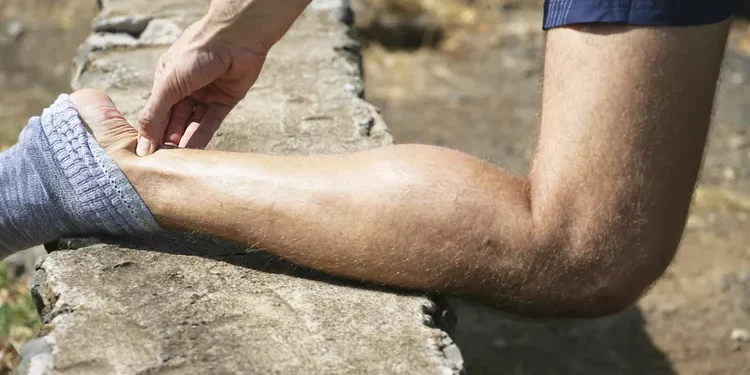Achilles tendonitis is a common injury that can affect almost anyone and affects the Achilles tendon, which connects the calf muscles to the heel bone. It is often caused by overuse and can cause pain, swelling, and stiffness in the heel and calf area. Trust me, if you’ve had Achilles tendonitis, then you know you’d do what you can do to prevent a future reoccurrence of injury.
 (Browse achilles tendonitis tools on Amazon), get to know these five exercises you can try at home using items around the home, or calf stretcher to help prevent or recover from Achilles tendonitis:
(Browse achilles tendonitis tools on Amazon), get to know these five exercises you can try at home using items around the home, or calf stretcher to help prevent or recover from Achilles tendonitis:
What are symptoms of Achilles Tendonitis?
The symptoms of Achilles tendonitis can vary from mild to severe, and they may include:- Pain and stiffness in the heel and calf area, especially in the morning or after physical activity
- Swelling and tenderness around the Achilles tendon
- A crackling or creaking sound when the tendon is moved or touched
- Weakness in the affected leg
Common causes of Achilles Tendonitis
When I had Achilles tendonitis, it was caused from running during a soccer game. It’s a very common injury related to marathon runners and causal joggers, and athletics, so no surprises there. However, Achilles tendonitis can happen to almost anyone from any activity. Achilles tendonitis can be caused by a number of factors, including:- Overuse or repetitive strain on the Achilles tendon from activities such as running or jumping
- Sudden increase in physical activity level or intensity
- Tight or weak calf muscles
- Flat feet or high arches, which can place more strain on the Achilles tendon
- Poorly fitting or worn-out shoes
- Certain medications, such as antibiotics or steroids
5 exercises to treat Achilles Tendonitis
Using an achilles stretcher, or calf stretcher, for tendonitis recovery can be an effective way to prevent or recover from Achilles tendonitis. Before you quickly go out to buy an achilles stretcher on Amazon to treat your Achilles tendonitis1. Calf stretch with a slant board
Calf stretching exercises on a slant board can be beneficial for both preventing and recovering from Achilles tendonitis. Here are a few reasons why:- Reduces tension in the Achilles tendon: Calf stretching exercises help to stretch the muscles in the calf, which in turn, reduces the tension on the Achilles tendon. This can help to prevent the tendon from becoming overused and injured.
- Increases flexibility: A lack of flexibility in the calf muscles can increase the risk of Achilles tendonitis. Stretching on a slant board can increase the range of motion in the calf muscles and improve flexibility, reducing the risk of injury.
- Promotes healing: For those recovering from Achilles tendonitis, stretching exercises can help to promote healing by increasing blood flow to the area. This increased blood flow can help to deliver essential nutrients and oxygen to the injured tissue, aiding in the healing process.
2. Eccentric heel drop
Eccentric heel drops on a slant board can be an effective exercise for preventing and recovering from Achilles tendonitis. Here’s why:- Specifically targets the Achilles tendon: The eccentric heel drop exercise places a specific focus on the Achilles tendon. This can help to strengthen and stabilize the tendon, reducing the risk of injury.
- Increases tendon strength: Eccentric exercises have been shown to increase tendon strength and resilience. This can help to prevent the tendon from becoming injured due to overuse or strain.
- Promotes healing: For those recovering from Achilles tendonitis, eccentric heel drops can help to promote healing by increasing blood flow to the area. This increased blood flow can help to deliver essential nutrients and oxygen to the injured tissue, aiding in the healing process.
- Stand on the slant board with the ball of one foot on the edge and the heel hanging off.
- Slowly lower your heel towards the ground, taking 3-4 seconds to do so.
- Once your heel is at the bottom of the range of motion, push back up to the starting position using your other foot to help.
- Repeat for 10-15 repetitions.
- Switch legs and repeat.
3. Single leg balance on a slant board
Single leg balance on a slant board is another exercise that can be helpful for preventing and recovering from Achilles tendonitis. Here’s how:- Improves balance and proprioception: Balancing on one leg on an unstable surface like a slant board requires the activation of the muscles in the foot and ankle, promoting better balance and proprioception. Improved balance and proprioception can help to reduce the risk of falls and missteps that can lead to Achilles tendonitis.
- Strengthens the calf muscles: The calf muscles play a crucial role in supporting the Achilles tendon. By standing on one leg on a slant board, you are effectively performing a calf raise, which can help to strengthen the calf muscles and take some of the load off the Achilles tendon.
- Enhances ankle mobility: Standing on a slant board requires the ankle joint to move through a greater range of motion than standing on a flat surface. This increased range of motion can help to improve ankle mobility, reducing the risk of Achilles tendonitis caused by restricted ankle mobility.
- Stand on the slant board with one foot, making sure the ball of your foot is centered on the board and your heel is hanging off the back.
- Lift your other foot off the ground, bending your knee slightly.
- Balance on the foot on the slant board for 20-30 seconds.
- Switch legs and repeat.
4. Toe raises
Toe raises on a slant board can be an effective exercise for preventing and recovering from Achilles tendonitis. Here’s how:- Strengthens the calf muscles: Toe raises on a slant board are a great way to strengthen the calf muscles, which play a critical role in supporting the Achilles tendon. Strengthening these muscles can help to take some of the load off the Achilles tendon, reducing the risk of Achilles tendonitis.
- Improves ankle mobility: Toe raises on a slant board require the ankle joint to move through a greater range of motion than regular calf raises. This increased range of motion can help to improve ankle mobility, which can also reduce the risk of Achilles tendonitis caused by restricted ankle mobility.
- Provides a more intense stretch: The slant board position provides a deeper stretch to the calf muscles than traditional calf raises, which can help to prevent tightness in the Achilles tendon and reduce the risk of Achilles tendonitis.
- Stand on the slant board with your toes on the board and your heels hanging off the back.
- Slowly raise up onto the balls of your feet, lifting your heels as high as you can.
- Hold for a few seconds, then slowly lower back down.
5. Achilles tendon stretch
An Achilles tendon stretch on a slant board is a simple yet effective exercise for preventing and recovering from Achilles tendonitis. Here’s how it works:- Relieves tension in the Achilles tendon: Tightness in the Achilles tendon is a common cause of Achilles tendonitis. An Achilles tendon stretch on a slant board can help to relieve tension in the tendon and prevent it from becoming too tight.
- Promotes blood flow to the tendon: Stretching the Achilles tendon on a slant board can also promote blood flow to the tendon, which can help to speed up the healing process in cases of Achilles tendonitis.
- Improves ankle mobility: The slant board position allows for a deeper stretch of the calf muscles and Achilles tendon, which can help to improve ankle mobility and reduce the risk of Achilles tendonitis caused by restricted ankle movement.
- Stand on the slant board with the balls of your feet on the board and your heels hanging off the back.
- Slowly lower your heels as far as you can towards the ground.
- Hold the stretch for 15-30 seconds, then slowly lift back up.
- Repeat for 3 sets of 10-15 reps.







